I'm not very familiar with the North West Coast of England although, over the years, I've made various visits. On the Longest Day in 2014, with the prospect of good weather, I decided to make a one-day trip by rail at least as far as Barrow-in-Furness and, possibly, beyond. I made an early start from home allowing me to catch the 06:37 Virgin 'Pendolino' service to Edinburgh which deposited me at Lancaster station in about 90 minutes.
Lancaster
From a railway point of view, Lancaster is the gateway to Furness and the Cumbrian Coast, if you are travelling from the south. The station is an imposing structure in stone which I briefly described in the earlier post Return to Heysham.
I had a little time to wait before the next onward service to Barrow-in-Furness, which gave me an opportunity to explore on foot the area around Lancaster Castle and the Priory Church of St Mary (which they confusingly now refer to as 'Lancaster Priory'). The Castle, of course, is built on a hill offering splendid views in various directions. It was a perfect morning, warming up nicely but still with a haze over the hills. Looking seawards, the two nuclear Power Stations at Heysham (described in Return to Heysham) were clearly visible. In another direction, the rooftops of the town were spread out, with attractive stone-built houses meandering down the hill from the Castle.
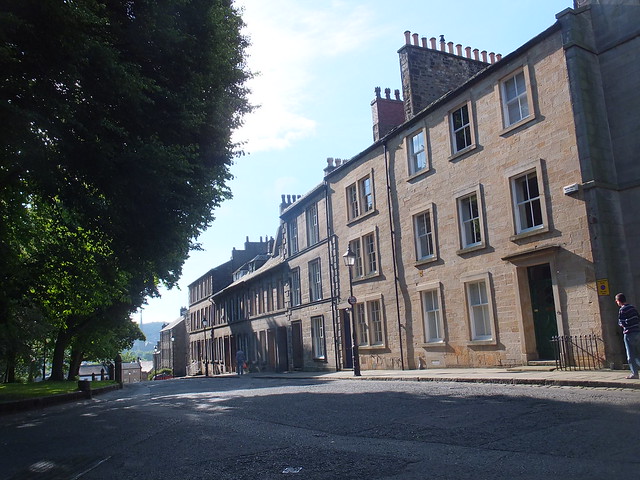 "...attractive stone-built houses meandering down the hill..."
"...attractive stone-built houses meandering down the hill..."
I descended the steep footpath past the site of the Roman Bath House (which I skipped on this brief visit) to the Town Quay on the River Lune. The Lune Millennium Bridge crosses the river here - a curving pedestrian bridge in a very modern style, cable-stayed from two massive pylons.
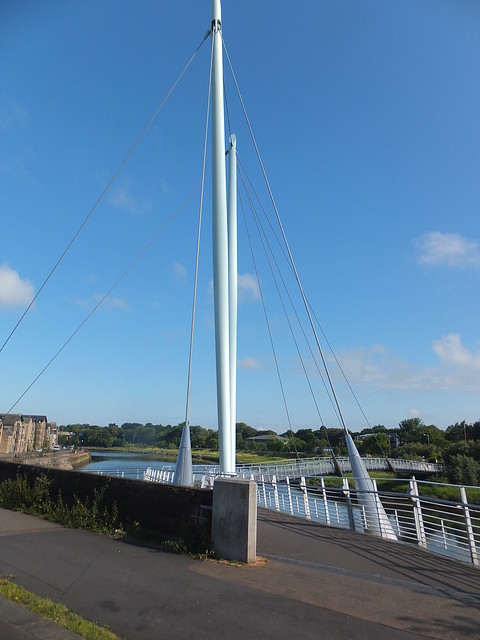
The Lune Millennium Bridge.
A little upstream, there was already plenty of traffic on the road bridge across the river. The 'Greyhound Bridge' had originally carried the former Midland railway line from Lancaster Green Ayre to Morecambe but, when the line was abandoned, the bridge was retained and converted for road traffic. I returned up the steep hill to the station and caught the slightly-delayed 09:02 stopping train to Barrow-in-Furness.
Carnforth and beyond
Our first station stop was at Carnforth. This was where many of the location scenes for the 1945 film 'Brief Encounter' were shot and the station still draws visitors because of that association, in fact, it has its own Heritage Centre and Refreshment Room. There's an interesting commentary on the film's continuing attraction on the 'Guardian' site here.
My train carried on, making brief stops at Silverdale, Arnside and Grange-Over-Sands (where the station is next to the sea front and a broad footpath extending along the coast encourages walkers). We continued, stopping at Kents Bank, Cark, Ulverston (with its rather elegant station buildings, featuring a tall clock tower), Dalton and Roose.
Barrow-in-Furness
As we approached Barrow, the broad, now apparently unused, expanse of Cavendish Dock appeared on our left. Beyond, there were signs of activity in Ramsden Dock with a couple of cargo ships. The port of Barrow is one of 21 operated by ABP (Associated British Ports) in Great Britain. There's a brief summary of Barrow's port facilities here and a plan of the port here. I believe there are still occasional trains from Ramsden Dock to the processing plant at Sellafield, carrying nuclear waste from nuclear power stations in Japan and the Netherlands for treatment.
Soon, my train was passing between rows of houses of a typical industrial town and stopping at Barrow, where I alighted, intending to spend about an hour looking around the town before continuing north on a later train. After Carlisle, Barrow is the second largest population centre in Cumbria with a present population of around 70,000.
I knew that the discovery of iron ore in Cumbria, together with coal, triggered the ironmaking and steelmaking industry in Barrow. I didn't realise that, around 1900, Barrow had the largest steelworks in the world, operated by the Barrow Hematite Steel Company Limited. Local iron ore deposits became exhausted in 1963 and steelmaking finally ceased in 1980.
Shipbuilding started in Barrow in 1871 but I didn't know that around 700 vessels had been built - there's a Wikipedia list here. Submarines are still constructed in Barrow by BAe Systems, see Wikipedia article. Shipbuilding now takes place under cover in the huge Devonshire Dock Hall (DDH). There's no traditional launch slipway - vessels are lowered into the water on a huge shiplift which can handle 24,300 tonnes!
For more information on Barrow, see the Wikipedia article.
Barrow-in-Furness railway station is modern but houses the original memorial to railwaymen who lost their lives in the Great War. The memorial shows obvious signs of damage - a small sign added below the memorial explains "THE DAMAGE TO THIS MEMORIAL WAS CAUSED BY ENEMY ACTION IN WORLD WAR II 1939-1945."
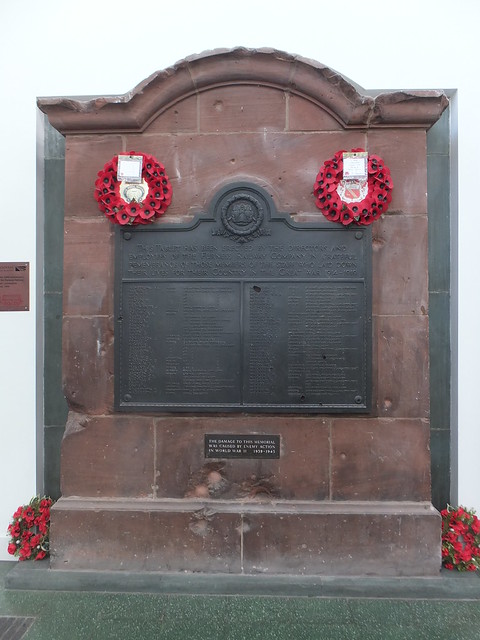
Click for larger size.
The War Memorial at Barrow-in-Furness railway station.
I quickly realised that Barrow's steelworks and shipbuilding yard had made the town an important target for the Luftwaffe in World War II. I learned afterwards that, in a series of air raids in 1941, 83 people in Barrow were killed and hundreds injured. There's a Wikipedia article on the Barrow Blitz.
I set off on foot towards the centre of the town, aiming for the sandstone clocktower of the tallest building around, which turned out to be the neo-Gothic Town Hall, completed in 1886. Although I passed a number of new buildings (the Courts, a modern shopping area including Debenhams and The Forum Entertainment Centre), sufficient older buildings remained to leave a sense of identity. A number of streets had been pedestrianised, which helps to give a human scale so I quite enjoyed my perambulation.
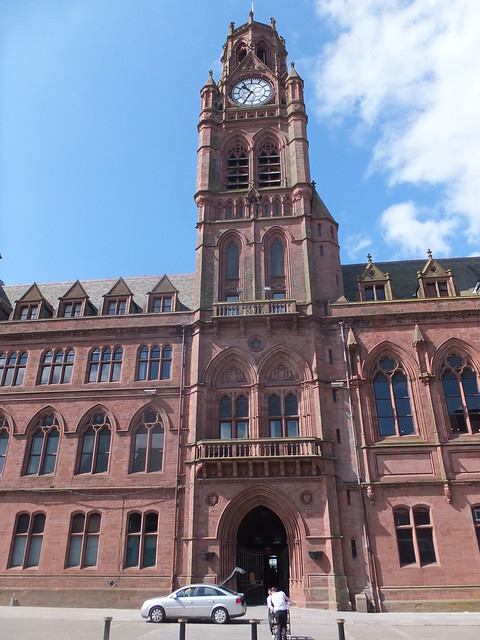
Barrow-in-Furness Town Hall.
One long area of water pierces through the town: this is Buccleuch Dock on the seaward end (including the Town Quay which berths two superannuated ships one of which served as the 'Blue Lagoon Night Club' until 2010) and Devonshire Dock at the landward end (terminated in the massive Devonshire Dock Hall mentioned above). The bridge carrying Michaelson Road divides the two docks.
 BAe System's covered shipbuilding hall at the end of Devonshire Dock, with the Shiplift visible outside the doors.
BAe System's covered shipbuilding hall at the end of Devonshire Dock, with the Shiplift visible outside the doors.
I retraced my route back to the station in time to catch the next northbound train.
Beyond Barrow
I joined the 11:22 to Whitehaven which had earlier come from Carlisle along what's presently marketed as 'The Cumbria Line' and was timed to arrive in bay platform 3 at Barrow at 11:08. Around the same time, the 09:45 from Preston was due in Platform 1 at 11:04, then returning to Lancaster at 11:20.
My train was allowed 77 minutes for the 46 mile journey to Whitehaven with a number of stops on the way. Some of these stations were request stops - tell the Guard if you want to get off, handsignal the approaching train if you want to get on. I don't remember 'missing out' any of the stops - it was a summer Saturday and there were plenty of passengers. In the following station list, the request stops are marked with an (x).
AskamThe railway continues to rely upon largely traditional operating methods with mainly semaphore signals, frequent signal boxes and even more frequent level crossings of various styles - User Worked, Manual Gates, the occasional Automatic Barrier.
Kirkby-in-Furness (x)
Foxfield (x)
Green Road (x)
Millom
Silecroft (x)
Bootle (x)
Ravenglass
Drigg (x)
Seascale
Sellafield
Braystones (x)
Nethertown (x)
St. Bees
Corkickle (x)
With excellent weather, the appeal of the area was obvious - on our right the mountains, on our left either low, rocky embankments dividing the railway from the sea or fields with grazing cows reaching to the sea shore. There did seem to be rather a lot of wind turbines but, I afterwards discovered, this is Britain's Energy Coast with the Mission Statement "To lead the transition of West Cumbria into an economy that will flourish in a low carbon future."
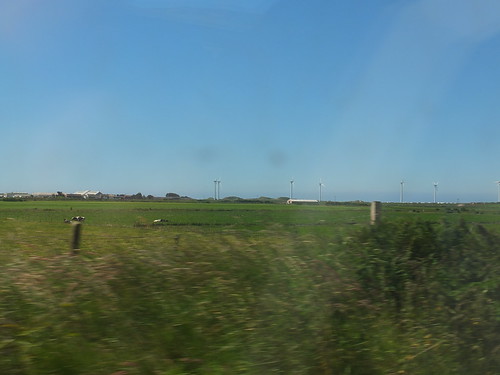 Green fields, cattle grazing ... and windfarms.
Green fields, cattle grazing ... and windfarms.
Ravenglass is a widely-known station, because a short walk leads to the terminus of the famous 'Ratty' - the Ravenglass and Eskdale 15-inch gauge steam railway which extends seven miles to Dalegarth.
About one and a half miles beyond Ravenglass, we stopped at Drigg station, with its signal box, manually-worked crossing gates and a siding trailing off on the Down side into an anonymous-looking well-fenced area. This remote area opened in 1940 as a wartime Royal Ordnance Factory for the manufacture of TNT explosive.
The next station is at Seascale - an almost-perfect seaside village with a population of around 1800. I say 'almost' because, as the picture below shows, around one mile north of the village is the industrial complex now known as Sellafield.
Sellafield
Sellafield has a small station next to the shore. On the landward site, the industrial complex stretches for some distance with a network of rail sidings where I spotted numerous odd-looking goods wagons and a couple of diesel locomotives. This site has a long and convoluted history which I'll outline below.
The industrial complex at Sellafield originated in 1942 as a wartime Royal Ordnance Factory. In 1950, Windscale Pile No. 1 was built here, followed by Windscale Pile No. 2 the following year. These were graphite-moderated, air-cooled nuclear reactors designed to produce weapons-grade plutonium for Britain's independent atomic (fission) bomb. Weapons technology advanced quickly and the Windscale facility was then adapted to produce Tritium for thermo-nuclear (fusion) weapons. In 1954 the United Kingdom Atomic Energy Authority took over the site.
The Magnox nuclear reactor (see Wikipedia) was British-designed. In 1953 building commenced on Calder Hall Power Station which had four Magnox reactors. See the Wikipedia article Calder Hall Power Station. Electricity was first fed to the National Grid in 1956 and the official opening was carried out by Queen Elizabeth II. There's a contemporary article published in 'The Engineer' here. I remember the optimistic publicity at the time, with talk of electricity being so cheap, it would no longer need to be metered. The Magnox reactor design is now obsolete and there's just one remaining commercial Magnox reactor in the U.K. (Wylfa on Anglesey, mentioned in the section 'Valley' of my article Trip to Holyhead).
In 1957, Windscale No. 1 suffered a fire which proved difficult to control and resulted in a major release of radio-activity (reduced by the filters included at the top of the stacks installed at the insistence of John Cockcroft which had previously been dubbed "Cockcroft's Folly"). Both reactors were taken out of use and No. 1, following a lengthy and expensive operation, has now been dismantled. See the Wikipedia article Windscale Fire.
The Windscale Advanced Gas Cooled Reactor (with its distinctive 'golf ball' shape) was built in 1962 as a prototype for later AGR reactors, for instance, Heysham (outlined in the section 'Heysham Nuclear Power Stations' in my post Railways around Morecambe). The Windscale AGR was taken out of use in 1981 and now serves as a 'demonstrator' for safe decommissioning procedures.
In 1971, most of the site was transferred to a Government-owned company, British Nuclear Fuels Limited (BNFL). Under BNFL, the 'THORP' (Thermal Oxide Reprocessing Plant) was approved in 1978 but only brought into use in 1994. In 2005 it stopped operating following a serious leak, but was restarted in 2007. See the Wikipedia article Thermal Oxide Reprocessing Plant. A major reorganisation of the site in 1981 also adopted the name 'Sellafield' but failed to transform operations into the anticipated commercial success. The First Generation Reprocessing Plant, the later Magnox Reprocessing Plant and the associated storage Ponds all now await decommissioning. The problems of dealing with radioactive waste have given rise to various other intiatives, all of which have proved expensive and not particularly satisfactory since high-level radioactive waste needs to be safely stored for thousands of years.
In 2004 the Nuclear Decommissioning Authority (NDA) took over from BNFL. This body is a Quango. Their website is here and there's a Wikipedia article here.
Sellafield: The actual work on the Sellafield site is carried out by Sellafield Limited, a company owned by Nuclear Management Partners Limited which is a consortium formed by URS (a large American engineering public company), AMEC (a large English engineering public company) and Areva (a large French engineering public company). Cynics might suggest that this convoluted arrangement ensures profit for the contractors without attracting the liabilities inherent in nuclear operations.
Drigg: In a similar manner, the former Royal Ordnance Factory at nearby Drigg (mentioned above) is also within the NDA remit and is now the National Low Level Waste Repository operated by LLW Repository Limited, a wholly-owned subsidiary of UK Nuclear Waste Management Ltd which is a consortium formed by URS (see above), Studsvik (a large Swedish engineering public company), Areva (see above) and Serco (a large English services public company).
Direct Rail Services: I hadn't realised that Direct Rail Services was owned by the Nuclear Decommissioning Authority. Originally, it solely operated nuclear flask trains, but its work has now expanded.
Capenhurst: My earlier post Birkenhead and New Brighton by train (Part 1) outlined the work of the Nuclear Decommissioning Authority at Capenhurst (although uranium enrichment on that site is carried out by Urenco UK.
Related sources:
Committee on Medical Aspects of Radiation in the Environment.
World Nuclear News.
On to Whitehaven
On leaving Sellafield, the railway line became single as we ran along an embankment a few yards from the beach. We passed a long line of houses on the beach huddled against the embankment with marvellous sea views. The older properties were wooden, large beach-huts but frequently extended and apparently cared for with neat gardens. Some of the houses were modern and brick built. Access to this curious village was by a sandy track running in front of the houses which dived under a railway bridge to reach normal roads.
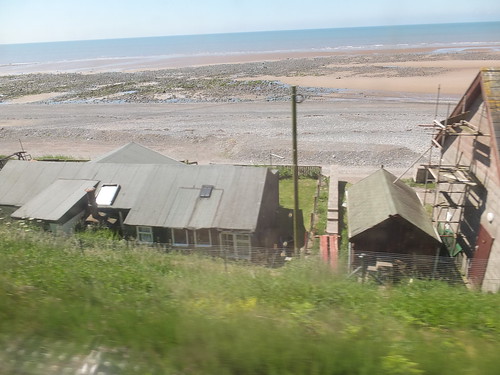 Beach Houses near Sellafield.
Beach Houses near Sellafield.
The train continued along the embankment through the village of Braystones and along the sea wall through Nethertown to St. Bees. Just north of the station we passed St. Bees School which has a history going back to 1587.
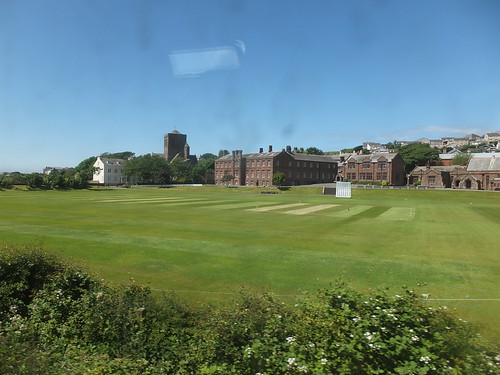 St. Bees School.
St. Bees School.
The line remained inland approaching Whitehaven. I was surprised at the size of the housing estate spread across the hill to our left - mature semi-detached and blocks-of-four housing. The population of Whitehaven, I later discovered, is around 23,000. We stopped at the first of Whitehaven's two stations, Corkickle. This was once the junction with a double-track line to Moor Row although, even then, the two routes converged onto a single platform serving Corkickle with a single line tunnel to the second station, Bransty. The junctions and sidings around Corkickle are long gone but the single platform and Whitehaven Tunnel (1,320 yards long, still single line) remain in use.
The rest of my travels that day are in the post Furness and the Cumbrian Coast (Part 2)
My pictures
Lancaster.
Barrow-in-Furness.
Cumbrian Coast Scenes.
Railway pictures
Carnforth railways.
Furness Line & Barrow.
Cumbrian Coast Line.
Whitehaven railways.
[Link to Part 2 added 1-Jul-2014]
